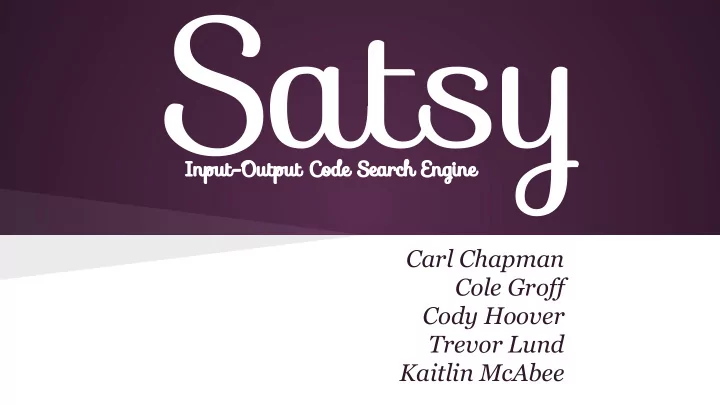

Satsy Input-Output Code Search Engine Carl Chapman Cole Groff Cody Hoover Trevor Lund Kaitlin McAbee
Problem Statement ● Lots of open-source code is available for use. ● Instead of rewriting code that already exists, can we search to find the existing code that does what we want? ● Assume we can describe functionality as an Input- Output pair.
Satsy Example
Google Example
Prototype Market Study VS. Results 48.4 20.5 Returned Satisfactory 1.5 8.5 Results [1]
Concept Sketch
Live Demonstration
Challenge 1: Technologies ● Amazon Web Services setup ● Running Java code from HTTP requests ● Running Z3 from Java application ● Asynchronous requests and responses ● JDBC connection pool ● Deploying Java web application
Challenge 2: AWS ● Why do some search queries seem to stall while others are much more responsive? ● Investigation reveals the AWS EC2 free-tier imposes CPU throttling.
Challenge 3: CPU Bound ● One Solver takes at least 60 Milliseconds of CPU time ● Searching 1000 database entries takes at least 1 minute
Original Design
Improved Design
Initialize Search 1. end old search 2. prepare new ResultMap and Executor 3. create collection of Solvers 4. launch all the Solvers using the new Executor
Solver Algorithm 1. check for search timeout 2. create SMT file 3. execute z3 and read result 4. increment result matrix 5. notify SearchCallback
Result Matrix
Database Structure
Paths Encoded as SMT
Ranking ● Generic superclass that can be extended to create new algorithms. ● Current algorithms are sorted by number of paths satisfied, percentage of paths satisfied and if all paths are satisfied.
Front End Design ● Single Page Web App ● Asynchronous Communication ● Template-based presentation
Testing 1: User Simulations ● Strong Engineering Effort put into comprehensive tests ● Relied on Blocking/All- or-nothing nature ● Architectural change -> Out the window
Testing 3: Revised Testing ● GUI: Manual “Mock” Flags ● Backend: Unit Tests ● Exceptional Cases: Database Integrity
Testing 2: SearchCallback ● Shift to Asynchronous/Incremental DeliveryArchitecture ● Less control over timing, more “events” ● On completion call SearchCallback
Questions
Recommend
More recommend